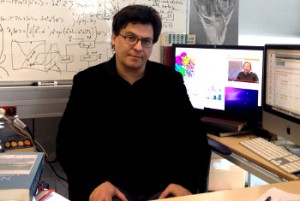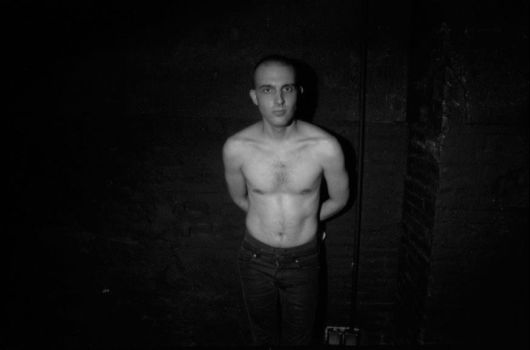The challenges and new discoveries in brain research are the subject of «The Brain», the ICREA-CCCB debate which, over the coming four Thursdays, will make known the work of some of the country’s leading researchers in the neurosciences. The cycle begins with a lecture by Ricard Solé, ICREA research professor at the Pompeu Fabra University, who will give the lecture Brain(s): automatons, accidents and sinthetic evolution on 11 March about synthetic life and the possibilities now being opened up for shaping and finding alternatives to Darwinian evolution.
What can we understand by synthetic evolution?
We work with complex systems and synthetic biology is part of our research in which we examine how far it is possible to go in construction and design on the basis of biological components, and whether we can create some kind of system that might carry out computations or make decisions, systems that might learn and that can imitate and that would therefore be comparable with the brain or neuronal systems. In my department we inquire into what can be done and what can’t be done. Evolution has created a series of structures like the brain, which is a great innovation, but we are asking, “would there be alternatives?” or “is this the only possible solution?” If some day we manage to develop the technology that would make it possible to imitate something like the brain, with intelligence, awareness, cognition or empathy, would this system necessarily have to imitate life? Or are there other alternatives? Starting from here, we formulate the question on many different scales.
What is the role of the brain in your research?
We can’t create brains in the laboratory but we’re working with cells that are normally individualist and only know how to look for food, and we’re managing to get them to communicate and make decisions as a group, like ants, so they can learn and make decisions, et cetera. Evolution invented that but we have the chance to change the process and introduce into it things that were not envisaged in evolution. And synthetic biology is making us reconsider things that once seemed clear, for instance aging or death. We all believed that aging was an inevitable process, pure thermodynamics, but this is false. Aging can be stopped. In fact, evolution has brought us to this point because the natural way is to live long enough to reproduce and that’s that. However, in the laboratory we have found that you can manipulate the ends of chromosomes and put one of the aging enzymes out of action. Mice that live three times longer than the usual lifespan have been produced and others have been made to die young. We can therefore skip this law, this “design principle”. We wonder how far we can go with these possibilities and if there are any alternatives to aging, or if we can design systems wherein aging doesn’t have to be one of the basic rules. This generates more questions and makes us think that there are many such things that we have taken for granted but, now, we should perhaps be calling them into question.>
The brain, for example, works optimally in many regards but is a disaster in many others. It’s able to function at very low levels of metabolic outlay, and we scientists are unable to reproduce this. Yet there are many very inefficient things. The brain has been building on what there was before so, within the human brain, there is the brain of the reptile, the brain of the rat, and so on, and this creates a lot of conflicts in the way we think and when it comes to having stupid beliefs. If we want to construct a machine, is it important to bear that in mind? Or how important is the fact that we have been children? We learn the language in a process of acquiring knowledge that begins in early childhood and have seen that, maybe because certain things happen in that process, we need to be children. There are people who are working on “child” robots and perhaps the design of complex systems has to go through a process of growth.
In any case, yours is research without immediate practical results…
Yes, it’s pure theory. We’ve always been theoreticians and it’s only in the last few years that we’ve had a laboratory in which to carry out experiments. The goal of our work is to try to understand the origins of complexity and part of it is related with cognition, with how you learn, how you incorporate information, how you adapt to an external world with the ability to predict or being unable to predict. Time is very important for the human being and, for example, time clearly distinguishes us from any machine. You know that there’s a past and a future but machines live in the present. How can we do this, endow a machine with this? Our job is to raise such questions even if we are a long way from knowing the answers.
Nevertheless, we have some laboratory results. Imagine that we can get some bacteria to behave like ants, so they can learn and collectively resolve problems. We’re trying to re-create in the laboratory how cooperation appeared millions of years ago. If we can do this, we’ll be opening up interesting horizons. We’d be able to design cells that could go to tissue and do what we want it to do – reconstruct it, for example.
How do you work? With powerful computers? With simulators?
You can approach the problem in many ways, from mathematics, to making theoretical models in which you approach the question in a very general way, through to computers where you can bring about evolution in circuits and artificial machines using Darwinian evolution. In other words, we don’t design them in the same way as an engineer would consciously go about it, but by trying to prompt their re-creation in the way that nature has evolved. Part of our inspiration also comes from science fiction when we read works that were written in the 1940s and 1950s, before the information revolution began. There are some very diverting things from that period. For example, the robot that cleaned the house wasn’t a Roomba but a robot in human shape with a vacuum cleaner in its hand. However, going beyond that, some science fiction is very interesting and it really transcends present-day technology. Science fiction also speculated on the brain-machine interface that might enable the brain to expand using technology but, from what we know about the brain at present, I very much doubt that this would be feasible.














